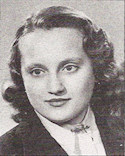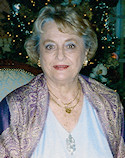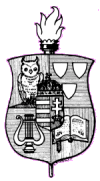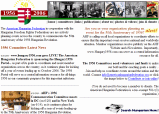 |
Éva B. Kisvarsányi in 1956 |
Éva B. Kisvarsányi
RECOLLECTIONS FROM 1956
In 1956 I was a 20-year-old university student in Budapest. I was born and raised in Budapest in a family of intellectuals in pre-World War II Hungary. My Grandfather was the chief engineer of the Capital City's Water Works, a job that carried a cabinet-Ievel position ("Miniszteri
Tanácsos") in pre-1945 Hungary. My Father was a meteorologist and served in the fledgling Hungarian Air Force as a weather observer/officer. He served a tour of duty on the Russian front, and by the end of the war, he rose to the rank of captain.
After the communist takeover in 1949 my father was interred to the provinces and my family lost everything. I was valedictorian of my High School graduating class in 1954 and had the seeond highest APT score among 200 applicants to the university, but was denied admission on
account of being a "class alien." With nothing to lose and being 18, I appealed the decision. After a lengthy process, and thanks to the courageous help and recommendations by the faculty and staff of the university, I was finally admitted as a freshman in Geology to the Eötvös
Loránd University in December 1954.
 |
Éva B. Kisvarsányi
in 2006 |
Unforgettable people
The most unforgettable person lever met has to be Imre Nagy, whom I met shortly before the Revolution on Kossuth Lajos Street. It was on a sunny but somewhat cool autumn day and he was wearing a light overcoat with no hat. My classrnates and I were going to have lunch in the City and we were wal king on the sidewalk when he suddenly appeared in the crowd walking toward us. We immediately recognized him and stared, unbelieving. I’ll never forget his face. He appeared calm and wise. It looked like he was just having a quiet stroll in the autumn sunlight. We did not talk and there was really not much to this meeting. but in retrospect I always felt that it was significant that I should have been so close to him. I know he was a communist, but I believe that when the chips were down, he stood with his people and his martyrdom washed away his sins.
The Revolution's Effect on my life
The Revolution really affected my life profoundly. Really, that is all can say. If it had not been for November 4 and the Soviet invasion, I would never have left my country. I marched with the students in the front row under the banner of "Eötvös Loránd Tudományegyetem" and decades later recognized myself on a French documentary about the Revolution, which aired on NBC television. My husband gave a rousing revolutionary speech to the plenary session of the University. After the Revolution was crushed, we were afraid of the retribution and having given up hope of getting help from the West, we left Hungary on December 1.
Our Escape
By the time we tried to leave in December, the borders were under close surveillance. We crossed the border to Austria at Pamhagen under the cover of night, partly on the back of a truck, partly on foot. At one point we passed by a stationary Soviet military column (about a dozen troop carriers full of armed men) headed by an empty jeep. I was certain they were going to kill us, but nothing happened. Our truck sped by them and we escaped. In retrospect we figured that the empty jeep was the key: the commanding officer was not in his place, and there was nobody to give the order to shoot!
I have to mention another incident right at the border. We were to cross into Austria at a place where the border is a narrow canal, maybe 10-15 feet wide. Refugees before us laid a tree across the canal to make it easier to cross. Our local guide told us that Russian troops stay a few kilometers inside from the border lest Western news agencies and photographers should spot Soviet troops on the border of neutral Austria, thus creating an "international incident." We arrived at the canal at the first dim light of dawn. As I was about to cross over the tree/bridge, two figures emerged from the mist. They were two young Hungarian conscripts with guns. In quiet, almost gentIe tones, they kept repeating the phrase over and over again: "It is not permitted to cross here." They did not draw their guns, however, and did not seem especially threatening. I remember their faces, too. Nice looking, young Hungarian boys. After a few seconds of hesitation, I started across the
tree/bridge and was soon across the border. The rest of our group, about 8-10 people, followed me. The two soldiers still stood on the other side and never fired a shot.
In America
I completed the university education I fought so hard for and had a successful and very satisfying professional life as a geologist and administrator with the State of Missouri. When my daughter left to go to college, she
asked me to tell her my story, so I did. I tape-recorded the entire history of the year 1956 for her, beginning
with the January earthquake (a real one!) up to our escape from Hungary. She asked for it in Hungarian and I
was happy to have granted her wish. She is bilingual, you see, and visited Hungary many times with us after
the 1963 amnesties made it easier to see our families.
Conclusion
The spirit of 1956, in a word, was freedom. We revolted against foreign occupation, tyranny, injustice, intellectual duress, and physical torture. I firmly believe that the 1956 Hungarian Revolution will enter the history books as the purest, cleanest and by far the most idealistic Revolution ever recorded by mankind.
[<< Back to all Featured Members]
[<< Back to All AHF News]
|
Buy [her books] and other products on the AHF Amazon Store 
Help AHF by purchasing all your products using the AHF Amazon Store! You pay nothing
more and AHF earns a small percentage:
More about Eva
 Born in Budapest, Éva B. Kisvarsányi was a Junior at the Eötvös Loránd
University in Budapest in 1956, majoring in geology. She participated in the students' march on October 23 under the banner of the University as the 1956 Hungarian Revolution began. After November
4, she and her husband, Géza Kisvarsányi, waited in vain for a month for help
from the West, and escaped to Austria in December. The Kisvarsányi's arrived in
the United States on January 16, 1957, and moved to Missouri. Eva continued
her study of geology at the University of Missouri, and earned a Bachelor of
Science in Geology in 1958, followed by a Master of Science in Geology in 1960
from that institution. From 1959 to 1993, she was employed at the Missouri
State Geological Survey, rising from the rank of research geoJogist through
Section Chief to Assistant Director. She has published more than 100 scientific
research papers, maps and books in the field of Precambrian geology. She retired
in 1993 and moved to Sarasota, Florida where she is the Executive Director of the Hungarian American
Cultural Association, Inc., The Kossuth Club of Sarasota, and founder and editor of the Club's newsletter, The
Hírmondó. Her books are available on the AHF Amazon Store! Born in Budapest, Éva B. Kisvarsányi was a Junior at the Eötvös Loránd
University in Budapest in 1956, majoring in geology. She participated in the students' march on October 23 under the banner of the University as the 1956 Hungarian Revolution began. After November
4, she and her husband, Géza Kisvarsányi, waited in vain for a month for help
from the West, and escaped to Austria in December. The Kisvarsányi's arrived in
the United States on January 16, 1957, and moved to Missouri. Eva continued
her study of geology at the University of Missouri, and earned a Bachelor of
Science in Geology in 1958, followed by a Master of Science in Geology in 1960
from that institution. From 1959 to 1993, she was employed at the Missouri
State Geological Survey, rising from the rank of research geoJogist through
Section Chief to Assistant Director. She has published more than 100 scientific
research papers, maps and books in the field of Precambrian geology. She retired
in 1993 and moved to Sarasota, Florida where she is the Executive Director of the Hungarian American
Cultural Association, Inc., The Kossuth Club of Sarasota, and founder and editor of the Club's newsletter, The
Hírmondó. Her books are available on the AHF Amazon Store! 
1956 Hungarian Revolution
 Videos posted to the 1956 Portal! "News Magazine of the Screen"
presented "Flight from Hungary" in early 1957 featuring video
taken after the brutal Soviet re-occupation. "This is battered Budapest
under the brutal Russian boot, Soviet tanks roam the streets under the
ruins they laid as communist secret police hunt down heroic Freedom Fighters.
25,000 Hungarians are dead." A fascinating video, it also includes
news about the Suez Crisis and more glimpes into life during this time.
Go to the [1956
Portal] Videos posted to the 1956 Portal! "News Magazine of the Screen"
presented "Flight from Hungary" in early 1957 featuring video
taken after the brutal Soviet re-occupation. "This is battered Budapest
under the brutal Russian boot, Soviet tanks roam the streets under the
ruins they laid as communist secret police hunt down heroic Freedom Fighters.
25,000 Hungarians are dead." A fascinating video, it also includes
news about the Suez Crisis and more glimpes into life during this time.
Go to the [1956
Portal]
 The
American Hungarian Federation is sponsoring the 1956 Portal to provide
a resource for Hungarian American organizations across the nation to highlight
and promote their 1956 Hungarian Revolution commemoration activities.
The 1956 Portal serves as a central information resource for 1956 as our
community prepares for this important milestone. The
American Hungarian Federation is sponsoring the 1956 Portal to provide
a resource for Hungarian American organizations across the nation to highlight
and promote their 1956 Hungarian Revolution commemoration activities.
The 1956 Portal serves as a central information resource for 1956 as our
community prepares for this important milestone.
Join online!

|



